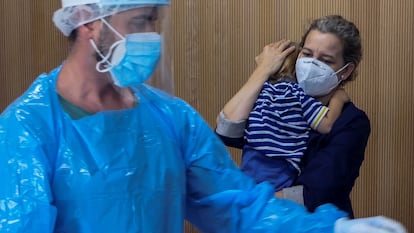MIS-C: The strange syndrome that is attacking some children one month after they are infected with the coronavirus
Spanish pediatricians have complied the most complete data about ‘multisystem inflammatory syndrome,’ which is a rare consequence of the SARS-CoV-2 virus and causes critical inflammation

A month after the first wave of the Covid-19 pandemic took hold, pediatricians from all over Spain started to detect cases of a syndrome that was so strange that it didn’t even have a name. It started to become clear at that time that the SARS-CoV-2 virus was causing serious illness above all else in the elderly and those with pre-existing medical conditions. That is why it was so strange to be finding children who, four to six weeks after having been infected with the coronavirus, would fall ill with continuous fever, general inflammation and other symptoms that put their lives at risk – despite having completely recovered from the initial infection.
“They were youngsters aged eight to 14 who were arriving with strong abdominal pains and fever lasting several days,” explains Alberto García-Salido, a pediatrician from the intensive care unit (ICU) at Madrid’s Niño Jesús Hospital. “They didn’t have respiratory symptoms like the adults did. The first thing we thought was appendicitis; then that it was an inflammatory syndrome due to a bacterial infection.”
The patients also presented red eyes, fever, nausea, vomiting and low blood pressure. After a couple of days, some of these children deteriorated, requiring admission to the ICU. While the illness could attack the major organs, most patients had heart complications.
MIS-C is the most serious pediatric complication that has been detected in this pandemic and the main reason for children to be admitted to ICUs
Initially, it was thought that it could be Kawasaki, a condition in children with no known cause that causes inflammation in the blood vessels. Later it was understood that it was a new condition related to the coronavirus. It was a group of signs and symptoms that are known to doctors as a syndrome, rather than a specific disease.
The World Health Organization (WHO) gave the condition a name in May, given the growing list of cases in the United Kingdom, the United States, France and Italy: Multisystem inflammatory syndrome in children (MIS-C). Since then, many doctors have begun to research this strange syndrome, but its causes are still unclear, as are the factors that determine why a child might have an infection with barely any symptoms only to become ill a month later to the point that their life is at risk.
“We are dealing with a very, very rare condition,” warns Alfredo Tagarro, a pediatrician at the Infanta Sofía hospital in Madrid and the coordinator of the national pediatric register in Spain for this new syndrome. In a study that has just been presented at the Congress on Retroviruses and Opportunistic Infections, his team analyzed data from 52 Spanish hospitals. From the start of the pandemic roughly 90 cases of MIS-C have been detected in Spain, which accounts for 0.02% of all the infections registered among people aged zero to 18 years old, explains Tagarro.
MIS-C is the most serious pediatric complication that has been detected in this pandemic and the main reason for children to be admitted to ICUs. Among the 90 cases, there were two deaths – both had pre-existing conditions.
Although it is a very rare syndrome, this underscores the importance of also vaccinating childrenFederico Martinón-Torres, pediatrician at Clínico Universitario hospital
The latency period between the infection and the arrival of the syndrome is highly variable, and it can arrive up to four months later, explains Cinta Moraleda, a pediatrician from the 12 de Octubre hospital in Madrid and the co-leader of the study. “We are trying to work out why this happens, what the immunological mechanism is,” she says. “For now we think that the SARS-CoV-2 infection works like the trigger of a gun that fires the immune response in patients that have a predisposition,” she adds.
The prevalence of this strange system in Spain is similar to that of other countries. There are so few cases in Spain that it is very difficult to draw statistically valid conclusions, including whether or not it affects boys more than girls (62% of the cases are male). All of the complications that have been detected appear to respond to the same cause: an uncontrolled reaction by the immune system caused by the virus. It’s very similar to what happens to older patients, the so-called cytokine storm, which causes serious Covid-19 and can end the life of the patient.
It is known that children can be infected by the coronavirus just like adults can, but they suffer much milder symptoms in general. The response of an organism against an infection has two major branches: one is innate, the frontline of the response, and the other adaptive, because it includes specialized molecules such as antibodies or the lymphocytes that are able to neutralize SARS-CoV-2 and eliminate the infected cells. In children, the innate response is much more active than in adults, which could explain why they stem the infection before it can cause complications or even mild symptoms.
In MIS-C that innate immune response is defective. Rather than effectively stemming the virus, the organism produces a generalized inflammation that can attack the lungs, the liver, the eyes, the brain and, above all, the heart. It is possible that the virus ends up staying in one of the organs and reappears after several weeks. There is data that supports this possibility. “One month after the infection, just 15% of children have a positive PCR test,” explains Tagarro. “By contrast, among children at risk of MIS-C that percentage rises to 45%,” he adds.
‘No after effects’
Doctors treat this syndrome with steroids to suppress the exacerbated immune response and with intravenous immunoglobulin that contains antibodies. “Now that we know what we are dealing with, as soon as we establish a link to the coronavirus we start to apply the treatment and the response is very fast, with a clear improvement in barely 12 hours,” explains García-Salido. “In the vast majority of cases, the syndrome is cured and leaves no after-effects.”
The syndrome in children is similar to the post-Covid complications that have already been detected in adults. At any rate, the associated mortality is very low, less than 2% of cases, according to Federico Martinón-Torres, a pediatrician at the Clínico Universitario hospital in Galicia. The situation, he says, was much worse in the first wave than the second and third, when the medical community was already on alert. “Now we are aware of what’s happening,” he explains. “But although it is a very rare syndrome, this underscores the importance of also vaccinating children,” he concludes.
Tagarro’s team has developed an online system to calculate the risk that a child will suffer this syndrome. It is based on markers that are common, such as, for example, a high concentration of inflammatory proteins in the blood, a lack of white blood cells and anemia.
English version by Simon Hunter.
Tu suscripción se está usando en otro dispositivo
¿Quieres añadir otro usuario a tu suscripción?
Si continúas leyendo en este dispositivo, no se podrá leer en el otro.
FlechaTu suscripción se está usando en otro dispositivo y solo puedes acceder a EL PAÍS desde un dispositivo a la vez.
Si quieres compartir tu cuenta, cambia tu suscripción a la modalidad Premium, así podrás añadir otro usuario. Cada uno accederá con su propia cuenta de email, lo que os permitirá personalizar vuestra experiencia en EL PAÍS.
¿Tienes una suscripción de empresa? Accede aquí para contratar más cuentas.
En el caso de no saber quién está usando tu cuenta, te recomendamos cambiar tu contraseña aquí.
Si decides continuar compartiendo tu cuenta, este mensaje se mostrará en tu dispositivo y en el de la otra persona que está usando tu cuenta de forma indefinida, afectando a tu experiencia de lectura. Puedes consultar aquí los términos y condiciones de la suscripción digital.
More information
Archived In
Últimas noticias
Daytime, headphones, no booze involved: How a generation is saying ‘no’ to club parties
Millennia-old Yuracaré language resists extinction through 900 speakers and a new dictionary
Susan Boyle prepares a comeback just as Timothée Chalamet sings her praises
Trump suspends green card visa lottery after shooting at Brown University
Most viewed
- Christian Louboutin: ‘Young people don’t want to be like their parents. And if their parents wear sneakers, they’re going to look for something else’
- US sanctions against jailed cartel leader ‘El Marro’ highlight Mexico’s lack of control over its prisons
- Cartels in Mexico take a leap forward with narco-drones: ‘It is criminal groups that are leading the innovation race’
- Liset Menéndez de la Prida, neuroscientist: ‘It’s not normal to constantly seek pleasure; it’s important to be bored, to be calm’
- ‘El Limones’ and the growing union disguise of Mexican organized crime











































